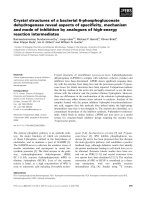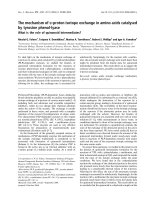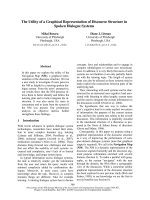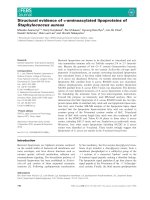báo cáo khoa học: " 3-D reconstruction of a human fetus with combined holoprosencephaly and cyclopia" pptx
Bạn đang xem bản rút gọn của tài liệu. Xem và tải ngay bản đầy đủ của tài liệu tại đây (5.36 MB, 11 trang )
BioMed Central
Page 1 of 11
(page number not for citation purposes)
Head & Face Medicine
Open Access
Research
3-D reconstruction of a human fetus with combined
holoprosencephaly and cyclopia
Wolfgang H Arnold*
†
and Veronika Meiselbach
†
Address: Department of Anatomy, Faculty of Dental Medicine, University of Witten/Herdecke, Alfred Herrhausenstrasse 50, 58448 Witten,
Germany
Email: Wolfgang H Arnold* - ; Veronika Meiselbach -
* Corresponding author †Equal contributors
Abstract
Background: The purpose of this study was to examine a human fetus with combined
holoprosencephaly and cyclopia by means of histology and 3-D reconstruction to determine the
internal structure and extent of the malformation.
Methods: The head from a human fetus at 20 weeks gestation and a diagnosis of
holoprosencephaly and cyclopia was investigated histologically and three-dimensionally
reconstructed with CAD techniques. The cranial bones, blood vessels, nerves, eye and brain
anlagen were reconstructed.
Results: The 3-D reconstruction revealed both severe malformation and absence of the facial
midline bones above the maxilla, and a malformation of the maxilla and sphenoid bone. The
mandible, posterior cranial bones, cranial nerves and blood vessels were normal. A synophthalmic
eye with two lenses was found. The prosencephalon was a single small protrusion above the
diencephalon. No nasal cavity was present. Above the single eye a proboscis was found.
Conclusion: The absence of the facial midline bones above the maxilla and the presence of a
proboscis as a nose-like structure above the cyclopic eye both mean that there was a
developmental defect in the fronto-nasal facial process of this fetus.
Background
Holoprosencephaly is a developmental disturbance
which is characterized by incomplete cleavage of the pros-
encephalon into two hemispheres and can also affect the
midline structures of the face. The clinical expression of
holoprosencephaly is extremely variable and suggests a
complex interaction of developmental, genetic and envi-
ronmental factors. The prevalence of holoprosencephaly
is 1/16,000 live births with an incidence of 1/250 in first-
trimester embryos [1]. The range of expression of holo-
prosencephaly varies from mild forms, wherein the right
and left ventricles are separated, but there is continuity
across the frontal cortex, to severe forms, where there is a
single brain and no interhemispheric fissure (alobar hol-
oprosencephaly). The severe forms are generally associ-
ated with facial deformities such as anophthalmia,
cyclopia, and the presence of a proboscis. Clinical reports
about newborn cases with mild forms of holoproscen-
cephaly are abundant, whereas embryological documen-
tation of the severe forms is scarce [2-9]. The most severe
forms of holoprosencephaly are usually incompatible
with postnatal life. For a better understanding of this mal-
Published: 29 June 2009
Head & Face Medicine 2009, 5:14 doi:10.1186/1746-160X-5-14
Received: 9 March 2009
Accepted: 29 June 2009
This article is available from: />© 2009 Arnold and Meiselbach; licensee BioMed Central Ltd.
This is an Open Access article distributed under the terms of the Creative Commons Attribution License ( />),
which permits unrestricted use, distribution, and reproduction in any medium, provided the original work is properly cited.
Head & Face Medicine 2009, 5:14 />Page 2 of 11
(page number not for citation purposes)
formation it is important to gain more embryological
data.
The pathogenetic mechanisms of holoprosencephaly are
still unknown, but both drug and alcohol abuse during
early pregnancy as well as genetic defects have been
described [1,7,10-13]. A number of genes have been dis-
covered to be involved, including sonic hedgehog (SHH)
[14,15], ZIC2 [16], SIX3 [17], TGIF [18], and others [1],
and they are now considered to be important in this devel-
opmental defect. It is now assumed that multiple genetic
hits and/or environmental exposures are required for the
expression of holoprosencephaly [19,20]. Therefore, the
multifactorial etiology of holoprosencephaly is consid-
ered to be the cause of the heterogeneity of the clinical
severity of the malformation.
One characteristic feature of the facial deformities in hol-
oprosencephaly is the defective structure in the median
plane. It comprises one orbit with a single cyclopic eye
(synophthalmia bilentica), a missing ethmoid complex, a
proboscis above the eye, severe hypotelorism, midfacial
hypoplasia, a midline cleft lip, the absence of nasal bones
and a single upper incisor [14]. In the literature, the pro-
boscis has been referred to as a nose-like structure
[5,6,14,21], but so far no detailed investigation of this
structure has been performed.
Human embryonic malformations may sometimes be
regarded as normal variants, which allows for the explana-
tion of some stages in normal development. In this
respect, detailed investigations of developmental distur-
bances not only enlighten pathological conditions, but
also give us hints about normal development.
The aim of this study was to investigate and describe in
more detail the defective bone structures, nerves and
blood supply of the facial and neural cranium of this
fetus.
Methods
Craniofacial tissues were studied in a spontaneously
aborted human fetus of undetermined sex and an esti-
mated age of 20 – 22 weeks. The maternal history was not
available. Due to formalin fixation prior to receipt of the
fetus, karyotyping was not possible.
After fixation in 10% formalin, the head was embedded in
paraffin and serial histological sections in the horizontal
plane were cut at a thickness of 10 μm. Every 10th section
was collected and alternately stained with either hematox-
ylin – eosin or azan. Photomicrographs of every section
were taken with a Nikon Coolpix 8400 camera with a res-
olution of 8 megapixels. In addition, the sections were
studied with a Leitz DMRB microscope (Leica, Wetzlar,
Germany) and additional microphotographs were taken.
A computer program for 3-D reconstruction and render-
ing, AutoCAD 2009 (Autodesk Inc., USA), was used. The
photographs of the sections were consecutively imported
into AutoCAD 2009 and superimposed according to the
method of the best fit. The outlines of the relevant struc-
tures were then digitized, each in separate layers. A total of
470 sections were digitized. Digitizing a single section
took between 5 and 30 minutes depending on the com-
plexity of the traced structures. From each structure, a 3-D
meshwork wire frame image was created. By freezing or
thawing single structures (electronic dissection), the
three-dimensional relation of different bones, nerves, and
blood vessels could be demonstrated.
Results
Gross anatomical features
The height of the head measured 5 cm, and its biparietal
width was 4 cm. The cyclopic face showed synophthalmia
with a single orbit (one eye with two pupils), an absent
nose and a proboscis above the eye (Fig. 1a). The mouth
was closed with no apparent clefting of the lips. After
opening the cranium, the remnants of the brain were
found, which appeared to be the diencephalon and a sin-
gle prosencephalic prominence anterior to the dien-
cephalon (Fig. 1b).
Cranial bones
The mandible appeared to be normally developed, with
five tooth anlagen on each side (Fig. 2). Both maxillae
were hypoplastic, with three tooth anlagen on each side.
Between the maxillae the anlage of a single midaxial inci-
sor was found (Fig. 3a). No nasal septum or nasal cavity
was present; instead, between both maxillae, a small lam-
ina of undifferentiated mesenchyme was demonstrated
histologically (Fig. 3b). Palatal bones, the sphenoid body
Photographs of the macroscopic appearance of the headFigure 1
Photographs of the macroscopic appearance of the
head. a) Frontal view of the investigated head. b) View of the
opened cranium with remnants of brain.
Head & Face Medicine 2009, 5:14 />Page 3 of 11
(page number not for citation purposes)
and the alae majores of the sphenoid appeared to be nor-
mally developed. However, only one optic canal with a
single optic nerve was found anterior to the sella turcica.
The alae minores of the sphenoid were absent (Fig. 4). No
ethmoid bone could be detected. The clivus zygomatic
and the temporal bones, including the middle and poste-
rior cranial cavity, showed no disturbances (Fig. 5). For
comparison to normal anatomy, refer to Arnold et al. [3].
Cranial nerves
From the cranial nerves the optic, oculomotor, abducens,
trigeminal, facial, vagus and hypoglossal nerves were
reconstructed. Except for the optic nerve and the missing
olfactory nerve, all other cranial nerves demonstrated a
normal anatomical course (Fig. 6). For comparison to
normal anatomy, refer to Arnold and Kleiner [22]
Cranial arteries
The external carotid artery showed a normal course and
branching. The internal carotid artery could not be fol-
lowed up until it met the basilar artery. The arterial circle
of Willis could not be detected. The basilar artery could be
reconstructed as far as the mesencephalon. In the middle
of the clivus the basilar artery disappeared (Fig. 7). For
comparison to normal anatomy, refer to Arnold and
Kleiner [22].
Orbit
The lateral borders of the single orbit were represented by
the left and right zygomatic bones, and the bottom were
the maxillary bones. The backside of the orbit was repre-
sented by the anterior side of the sphenoid body and lat-
erally by both alae majores of the sphenoid. No bony roof
Overview of cranial bonesFigure 2
Overview of cranial bones. Rendered 3-D reconstruction of cranial bones, left oblique view. Mandible and maxilla are in
transparent colors to show the tooth germs within the bones.
Head & Face Medicine 2009, 5:14 />Page 4 of 11
(page number not for citation purposes)
Overview and histology of maxillary boneFigure 3
Overview and histology of maxillary bone. a) Rendered 3-D reconstruction of maxillary bones in transparent color
depicting 3 tooth germs on each side and a single midaxial incisor. b) Histological section of the intermaxillary lamina with
undifferentiated mesenchyme between the maxillary bones. Azan staining.
Head & Face Medicine 2009, 5:14 />Page 5 of 11
(page number not for citation purposes)
Maxilla and sphenoid complexFigure 4
Maxilla and sphenoid complex. a) Rendered 3-D reconstruction of the maxillary complex and eye, left upper view. There
is a single eye within the orbit containing two retinae. A single optic nerve leaves the orbit through a central optic canal. b)
Rendered 3-D reconstruction of the sphenoid complex with the pterygoid, palatal bones, and sphenoid bone in the right view.
The paired retinae and the optic nerve are also shown.
Head & Face Medicine 2009, 5:14 />Page 6 of 11
(page number not for citation purposes)
of the orbit was present. The orbit contained a single
cyclopic eye with two lenses and retinae (Fig. 8). From the
two retinae a pair of optic nerves derived, which formed a
single optic nerve behind the eye. This single optic nerve
passed a single central optic canal and ended within the
diencephalon. The optic nerve contained an inner cavity
which continued into the diencephalon.
Proboscis
Above the cyclopic eye originated a single midline probos-
cis. The proboscis was represented by a circular wall of
hyaline cartilage with a central canal. The inner lining of
this central canal contained respiratory epithelium which
is supported by loose connective tissue. Along the bottom
of the proboscis a pair of nerves was found, but they did
not enter the central canal (Fig. 9).
Discussion
The gross anatomical features of the described case are
similar to those which have been reported previously in
the literature, such as a synophthalmic eye, an unpaired
orbit, a proboscis above the eye and an alobar telen-
cephalon[3-6,8,9,23]. This description of another holo-
prosencephalic case adds more information to the scarce
literature about embryonic holoprosecephaly. One of the
main features in the described case is the absence of a
mesethmoid which, during normal embryogenesis, gives
rise to the nasal capsule. The ethmoid complex is a deriv-
ative of the fronto-nasal process which develops from the
prechordal mesoderm and divides the developing face
into a left and right side. The ethmoid complex plays an
important role in the lateralization of the paired structures
of the face [24,25]. Failure in the development of the eth-
Overview of cranial baseFigure 5
Overview of cranial base. Rendered 3-D reconstruction of the inner cranial base, upper view. In the frontal part, the eth-
moid is missing and there is a single optic canal in the body of the sphenoid.
Head & Face Medicine 2009, 5:14 />Page 7 of 11
(page number not for citation purposes)
moid has extensive consequences in facial development
and results in malformations of the entire middle and
upper face. A remnant of the missing ethmoid may be the
proboscis above the eye. This structure is represented by a
tube-like cartilage with a central canal which is lined by
respiratory epithelium. Therefore, the term "nose-like,"
which has been used in the literature, [6,14,21] may be
somewhat correct. If there is no definition of the median
cranial plane, lateralization is impossible, and thus results
in the expression of the holoprosencephalic phenotype.
Thus holoprosencephly may be regarded as a failure in lat-
eralization of the most anterior parts of the neural tube
and the developing facial cranium.
The chorda dorsalis determines the bilateral symmetry
and the pattern of the segmentation of the entire post-cra-
nial body by the expression of Hox genes [26]. The skele-
tal derivatives of the cranial neural crest anterior to the
chorda dorsalis are patterned through a combination of
intrinsic differences between neural crest cells and extrin-
sic signals from adjacent tissues [27], and therefore are dif-
ferent from the rest of the body. The determination of the
cranial median plane in early embryonic development
may be under the control of various factors such as differ-
ent genes, the most important of which is SHH
[15,23,28,29], but environmental influences have also
been implicated [28].
Overview of the course of main cranial nervesFigure 6
Overview of the course of main cranial nerves. a) Left oblique slight upper view of a rendered 3-D reconstruction of the
abducens, oculomotor and trigeminal nerves. The left temporal bone and the left mandible have been removed. b) Left frontal
view of a rendered 3-D reconstruction of the facial, vagus, and hypoglossal nerves. c) Left oblique upper view of the course of
the facial nerve within the temporal bone.
Head & Face Medicine 2009, 5:14 />Page 8 of 11
(page number not for citation purposes)
The incomplete arterial circle of Willis in this case is in
accordance with other findings in holoprosencephly. It
has been described that the arterial circle of Willis is
incomplete in severe cases of holoprosecephaly [2,30]
and may be related to the malformation of the central
nervous system. The internal carotid artery disappeared
just before it could enter the remnants of the telen-
cephalon. The basilar artery could only be followed up to
the anlage of the mesencephalon. The reason for the
incomplete arterial supply may be, as in other cases, the
malformation of the brain anlage.
Conclusion
Holoprosencephaly seems to be a malformation of the
most rostral parts of the brain and the cranium, as it
affects mainly the telencephalon and the upper portion of
the facial cranium. From the results of this investigation,
and in combination with previous reports, it can be con-
cluded that there is a defect in the definition of the
median plane in embryonic development.
The histological finding of the proboscis with a respira-
tory epithelial lining leads to the conclusion that it is a
nose-like structure and part of the fronto-nasal process
which failed to develop properly.
It further can be concluded that the ethmoid plays an
important role in the development of the bilateral sym-
metry of the face, and may play an important role in the
determination of the median plane.
Competing interests
The authors have no competing interests as the research
has been carried out with University funds.
Overview of main cranial arteriesFigure 7
Overview of main cranial arteries. Left oblique view of a rendered 3-D reconstruction of cranial arteries. The temporal
and zygomatic bones have been removed.
Head & Face Medicine 2009, 5:14 />Page 9 of 11
(page number not for citation purposes)
3D reconstruction of orbital bonesFigure 8
3D reconstruction of orbital bones. a) Right oblique upper view of the orbital bones containing a single eye and two reti-
nae. The single optic nerve is connected with the diencephalon. b) Detail of the optic nerve with two retinae. The optic nerve
is connected with the diencephalon leaving the orbit through one central optic canal.
Head & Face Medicine 2009, 5:14 />Page 10 of 11
(page number not for citation purposes)
Histology of proboscisFigure 9
Histology of proboscis. a) Overview of a histological section of the proboscis showing the closed circular cartilaginous wall
(arrow 1) with a central canal (arrow 2) with an epithelial lining (arrow 3) supported by loose connective tissue (arrow 4)
which contains blood vessels and two nerves at the posterior side (arrow 5). b) Higher magnification of the epithelial lining of
the central canal, depicting a respiratory epithelium with cilia (arrow 1) and goblet cells (arrow 2).
Publish with Bio Med Central and every
scientist can read your work free of charge
"BioMed Central will be the most significant development for
disseminating the results of biomedical research in our lifetime."
Sir Paul Nurse, Cancer Research UK
Your research papers will be:
available free of charge to the entire biomedical community
peer reviewed and published immediately upon acceptance
cited in PubMed and archived on PubMed Central
yours — you keep the copyright
Submit your manuscript here:
/>BioMedcentral
Head & Face Medicine 2009, 5:14 />Page 11 of 11
(page number not for citation purposes)
Authors' contributions
WHA: Identified the histological structures, supervised the
project and wrote the manuscript.
VM: Did the 3-D reconstruction.
Both authors read and approved the final version of the
manuscript.
References
1. Dubourg C, Bendavid C, Pasquier L, Henry C, Odent S, David V: Hol-
oprosencephaly. Orphanet J Rare Dis 2007, 2:8.
2. Arnold WH, Sperber GH, Machin GA: Anatomy of the circle of
Willis in three cases of human fetal synophthalmic holopros-
encephaly. Ann Anat 1996, 178:553-558.
3. Arnold WH, Sperber GH, Machin GA: Cranio-facial skeletal
development in three human synophthalmic holoprosen-
cephalic fetuses. Ann Anat 1998, 180:45-53.
4. Kjaer I, Keeling JW, Fischer Hansen B, Becktor KB: Midline skele-
todental morphology in holoprosencephaly. Cleft Palate Cranio-
fac J 2002, 39:357-363.
5. Kjaer I, Keeling JW, Graem N: The midline craniofacial skeleton
in holoprosencephalic fetuses. J Med Genet 1991, 28:846-855.
6. Muller F, O'Rahilly R: Mediobasal prosencephalic defects,
including holoprosencephaly and cyclopia, in relation to the
development of the human forebrain. Am J Anat 1989,
185:391-414.
7. Sperber GH, Honore LH, Machin GA: Microscopic study of holo-
prosencephalic facial anomalies in trisomy 13 fetuses. Am J
Med Genet 1989, 32:443-451.
8. Sperber GH, Johnson ES, Honore L, Machin GA: Holoprosen-
cephalic synophthalmia (cyclopia) in an 8 week fetus. J Cranio-
fac Genet Dev Biol 1987, 7:7-18.
9. Yamada S: Embryonic holoprosencephaly: pathology and phe-
notypic variability. Congenit Anom (Kyoto) 2006, 46:164-171.
10. Fitz CR: Holoprosencephaly and related entities. Neuroradiol-
ogy 1983, 25:225-238.
11. Johnson VP: Holoprosencephaly: a developmental field defect.
Am J Med Genet 1989, 34:258-264.
12. Leech RW, Shuman RM: Holoprosencephaly and related mid-
line cerebral anomalies: a review. J Child Neurol 1986,
1:3-18.
13. Ronen GM, Andrews WL: Holoprosencephaly as a possible
embryonic alcohol effect. Am J Med Genet 1991, 40:151-154.
14. Belloni E, Muenke M, Roessler E, Traverso G, Siegel-Bartelt J, Frumkin
A, Mitchell HF, Donis-Keller H, Helms C, Hing AV, et al.: Identifica-
tion of Sonic hedgehog as a candidate gene responsible for
holoprosencephaly. Nat Genet 1996, 14:353-356.
15. Chiang C, Litingtung Y, Lee E, Young KE, Corden JL, Westphal H,
Beachy PA: Cyclopia and defective axial patterning in mice
lacking Sonic hedgehog gene function. Nature 1996,
383:407-413.
16. Brown LY, Hodge SE, Johnson WG, Guy SG, Nye JS, Brown S: Pos-
sible association of NTDs with a polyhistidine tract polymor-
phism in the ZIC2 gene. Am J Med Genet 2002, 108:128-131.
17. Wallis DE, Muenke M: Molecular mechanisms of holoprosen-
cephaly. Mol Genet Metab 1999, 68:126-138.
18. Gripp KW, Wotton D, Edwards MC, Roessler E, Ades L, Meinecke P,
Richieri-Costa A, Zackai EH, Massague J, Muenke M, Elledge SJ: Muta-
tions in TGIF cause holoprosencephaly and link NODAL sig-
nalling to human neural axis determination. Nat Genet 2000,
25:205-208.
19. Krauss RS: Holoprosencephaly: new models, new insights.
Expert Rev Mol Med 2007, 9:1-17.
20. Ming JE, Muenke M: Multiple hits during early embryonic devel-
opment: digenic diseases and holoprosencephaly. Am J Hum
Genet 2002, 71:1017-1032.
21. Hausmann N, Stefani FH, Lund OE: Diplophthalmia versus
cyclopia and synophthalmia. Mechanisms of doubling of the
eye. Doc Ophthalmol 1992, 79:201-219.
22. Arnold WH, Kleiner A: 3D reconstruction of the cardiovascular
and central nervous system of a human embryo Carnegie-
stage 15 – case report. Ann Anat 2004, 186:133-139.
23. Roessler E, Belloni E, Gaudenz K, Jay P, Berta P, Scherer SW, Tsui LC,
Muenke M:
Mutations in the human Sonic Hedgehog gene
cause holoprosencephaly. Nat Genet 1996, 14:357-360.
24. Latham RA, Scott JH: A newly postulated factor in the early
growth of the human middle face and the theory of multiple
assurance. Arch Oral Biol 1970, 15:1097-1100.
25. Siebert JR: The ethmoid bone: implications for normal and
abnormal facial development. J Craniofac Genet Dev Biol 1982,
1:381-389.
26. Wellik DM: Hox patterning of the vertebrate axial skeleton.
Dev Dyn 2007, 236:2454-2463.
27. Knight RD, Schilling TF: Cranial neural crest and development
of the head skeleton. Adv Exp Med Biol 2006, 589:120-133.
28. Cohen MM Jr, Shiota K: Teratogenesis of holoprosencephaly.
Am J Med Genet 2002, 109:1-15.
29. Hu D, Marcucio RS: A SHH-responsive signaling center in the
forebrain regulates craniofacial morphogenesis via the facial
ectoderm. Development 2009, 136:107-116.
30. van Overbeeke JJ, Hillen B, Vermeij-Keers C: The arterial pattern
at the base of arhinencephalic and holoprosencephalic
brains. J Anat 1994, 185(Pt 1):51-63.







![Tài liệu Báo cáo khoa học: Specific targeting of a DNA-alkylating reagent to mitochondria Synthesis and characterization of [4-((11aS)-7-methoxy-1,2,3,11a-tetrahydro-5H-pyrrolo[2,1-c][1,4]benzodiazepin-5-on-8-oxy)butyl]-triphenylphosphonium iodide doc](https://media.store123doc.com/images/document/14/br/vp/medium_vpv1392870032.jpg)

